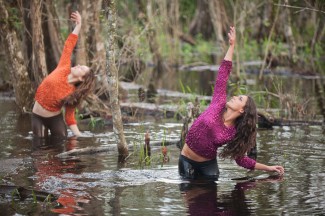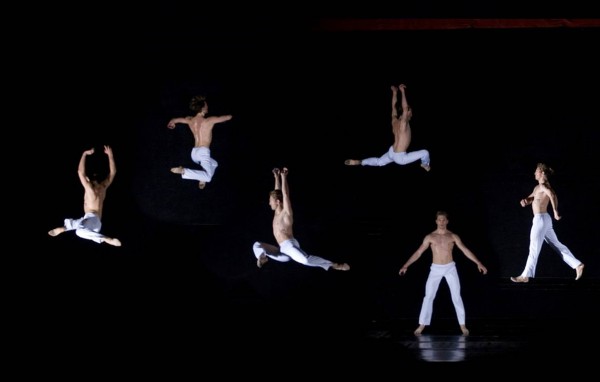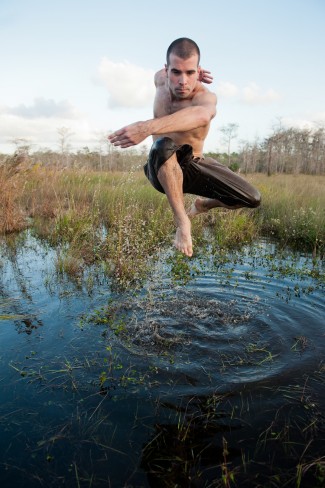INTERVIEW: David Parsons takes his dancers deep into the swamplands

David Parsons, the accomplished modern dancer who has headed his own company for more than 25 years, loves the thrill of presenting new material to an audience hungry for novelty. Through graceful, alluring and rhythmic moves, his dancers appear to fly through the air, contorting their bodies, encircling their arms, grasping for the dependability of a nearby partner.
David Parsons Company brings these indelible moves to the Joyce Theater in Manhattan through Jan. 27. The two-hour program features both classic Parsons routines, including “Caught” and “Wolfgang,” plus local premieres like “Dawn to Dusk” and “Black Flowers.”
Speaking a day before the lights came up for the first time at the Joyce, Parsons was excited for the prospects of the two-week run. “It’s good because we’re ready,” he said by phone. “We’ve been a company here in New York for many years, a couple of decades. So we’ve got it down. And we’re just really excited to be able to get it on stage. We rehearse. It’s real physical stuff, you know. … I’m really a good person in rehearsals. I really love to pull it out of the dancers, and they love that, too.”
The hallmark piece in the new program is “Dawn to Dusk,” a multimedia spectacle that traces its origins to the swamps of southern Florida. “It’s an excerpt from a full-length evening piece done at Wolf Trap outside of Washington, D.C.,” Parsons said. ” It’s a 7,000-seat theater, and this September, we did a performance, a full-length evening with Tiempo Libre out of Miami and Andrew Bird, who just got a Grammy Award this year, for his kind of naturalistic vibe that he has musically. It’s quite beautiful. And we did a whole piece celebrating the national parks of Florida.”
The company traveled down to Florida four months before the Wolf Trap premiere. The dancers performed in the parks, including the Everglades, Dry Tortugas and Big Cypress, and videographers filmed their movements in marshes and dunes. The actual dance routine is performed in front of large projections of these Florida landscapes, creating a symbiotic relationship between the dancer’s image on the screen and the dancer’s body on the stage.
“I thought it would be great to bring it to the Joyce, in an excerpt,” he said. ” It’s wonderful to be able to celebrate nature.”

Admittedly there is an enormous difference between performing in nature and performing on a dance stage. “When you did it in the swamps, you couldn’t get your footing very easy,” Parsons said. “But then we also add to it with live performance in front, where they can really have their footing on stage. So you’ll be able to see them six months ago in the swamps and then on stage in front of their own images. There’s a lot of animalistic, very physical movement that’s being done. … It’s got a little nice primitive effect to it, so I think they really enjoyed it.”
The choreographer stressed the inherent variety behind Parsons Dance routines. The Joyce program, for example, jumps from southern Florida to a work called “Black Flowers,” choreographed by Katarzyna Skarpetowska and set to the music of Frédéric Chopin. “It’s really dark and lovely,” he said. “It’s about a trio of women.”

Another piece is “Caught,” perhaps the most famous work from the company. “It’s one of my signature works,” Parsons said. “The music is by Robert Fripp, and it’s a solo 5 minutes long, but it’s really something that is always amazing to watch. It’s done on a dark stage where strobe lights hit the dancer at the top of their leap. So it gives the effect of flying. … The audience demands it, and you don’t get too many pieces like that.”
“Caught” is worked into the repertoire, but Parsons is mostly interested in new material. “The object for me is to take the audience to new territory,” he said. “Either that or you don’t survive. You’ve got to keep pushing yourself into new territory. It’s not even a question. You’ve got to keep going forward.”
Parsons seems to be a choreographer in love with the music of his dances. Many times, it’s actually the song or melody that comes first during the conceptual stage; the movements come next. For example, another piece that will play at the Joyce is “In the End,” set to the music of the Dave Matthews Band. Parsons called the routine “like a soundtrack” or “like a glove.” “I love it when the music and dance become one, man,” he added, almost like he were a chef and the sound and visuals his ingredients for a delicious dish.
Parsons enjoys his time at the head of the company so much that he doesn’t think too often about taking to the stage once again, like back in his early days with the Paul Taylor Dance Company and New York City Ballet. “I’ve kind of done the dancing thing,” he said. “I’ve done that, and I really like being in the background. For me, it’s all about creation. I want to make something you won’t forget, and that’s enough of a challenge right there.”
It must be somewhat cathartic for Parsons to find such success in his adopted city of New York. The memories of his first time in the Big Apple are still burned into his mind. “I came to New York when I was 17, man — straight off the train from Kansas City,” he said. “The whole time I was basically a teenager in Paul (Taylor)’s company, and we were touring worldwide. … What I look back fondly on is we did not have to worry about anything but dancing, man. That is something. Money can’t buy that. It’s a great feeling as a young person just to be able to travel the world and dance with people. And you’ll be able to see the joy of that when you come and see my company. You’ll be able to see young people who are in a place in their lives that they are definitely enjoying. That comes off like you wouldn’t believe.”
By John Soltes / Publisher / John@HollywoodSoapbox.com
-
Parsons Dance continues at the Joyce Theater through Jan. 27. Click here for more information.

